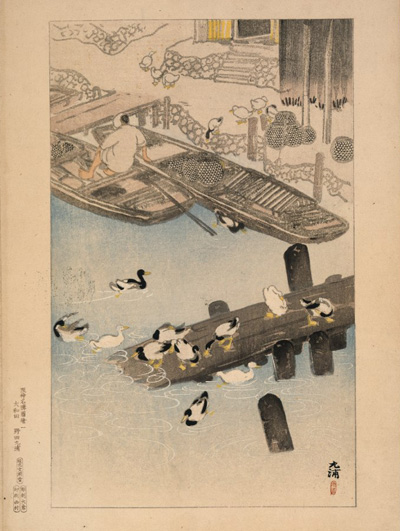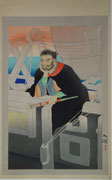Biographical Data
Biography
Noda Kyūho 野田九浦 (1879-1971)
Sources: Guide to Modern Japanese Woodblock Prints: 1900-1975, Helen Merritt, University of Hawaii Press, 1992, p. 110 and Modern Japanese Prints: 1912-1989, Lawrence Smith, British Museum Press, 1994, p. 32Noda Kyūho, given name Dosan, was born in Tokyo in 1879. He studied Japanese-style painting with Kogyo Terazaki (1866-1919) and Western style painting at Hakubakai (The White Horse Society). He attended the Tokyo School of Fine Arts for a year around 1896 where he developed the sketching ability that allowed him to earn his living as an illustrator for the Osaka newspaper Asahi shinbun. In Osaka, he also did book illustration and became a friend of the nihonga and woodblock artist Tsunetomi Kitano (1880-1947). In 1917 he returned to Tokyo where he remained, concentrating on nihonga paintings with cultural and religious themes.
He exhibited at the government sponsored Bunten (Fine Art Exhibition of the Ministry of Education) and his work Tsitji Seppo (Roadside Preaching), won an award at the first Bunten in 1907.1 He was one of five artists working for the Asahi shinbun who contributed to the 1916 series Pictures of famous places in Osaka and Kobe (Hanshin meisho zue) (see below) and to Supplements of the Complete Works of Chikamatsu Manzaemon, 1922-1925. Several of his paintings are held by The National Museum of Modern Art, Tokyo.
One of his students was the female artist Shima Seien.

Noda Kyūho 1916-17 print contribution to the series Hanshin meisho zue
(Pictures of Celebrated Places in Osaka and Kobe)
The British Museum 1991,0805,0.22
The British Museum 1991,0805,0.22
1 "Japanese Culture in the Meiji Era," Fujii (Jintaro), Outline of Japanese History in the Meiji Era, Volume VII, Obunsha, 1958, p. 497, 504
